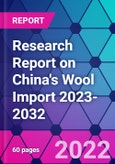In 2021, China imported 286,000 tons of wool (uncombed wool, the same below), up 29.2% year-on-year, and the import value was US$2.40 billion, up 47.9% year-on-year. 217,000 tons of wool were imported into China in the first three quarters of 2022, down 3.8% year-on-year, and the import value was US$1.73 billion, down 8.8% year-on-year.
The average price of China's wool imports fluctuates slightly in 2018-2022, with a relatively stable average price of wool imports in 2018-2019 and a decline in 2020 to US$7.3 per kg, down 16.1% y-o-y. According to The publisher analysis, the average wool import price rises to US$8.4 per kg in 2021, up 14.5% y-o-y. The average wool import price falls again to US$8.0 per kg in the first three quarters of 2022.
The main types of wool imported into China are uncombed fat-bearing sheep's wool, uncombed degreased sheep's wool (uncarbonized) and uncombed carbonized wool. In 2021, China imported 244,000 tons of uncombed fat-bearing sheep's wool, accounting for 85.4% of total imports and US$2.32 billion, or 96.7% of total imports in that year.
The main types of wool imported into China are uncombed greasy shorn wool, uncombed degreased shorn wool (uncarbonized) and uncombed carbonized wool. In 2021, China imported 244,000 tons of uncombed greasy shorn wool, accounting for 85.4% of total imports and US$2.32 billion, or 96.7% of total imports in that year.
In 2021, China imported wool from 38 countries. According to the publisher's analysis, China's major sources of wool imports by volume are Australia, New Zealand, South Africa, the UK and Mongolia, with wool imports from these five countries accounting for more than 85% of total imports. In 2021, China imported 181,000 tons of Australian wool, accounting for 63.3% of total imports and US$1.89 billion, or 78.9% of total imports that year.
China is the world's largest consumer of wool, and with increasing demand for wool, China's domestic wool production levels have been unable to meet processing market demand, resulting in an expansion of China's wool imports and a gradual increase in import dependence. The publisher expects China to continue importing wool from 2023-2032.
Topics covered:
- China's Wool Import Status and Major Sources in 2018-2022
- What is the Impact of COVID-19 on China's Wool Import?
- Which Companies are the Major Players in China's Wool Import Market and What are their Competitive Benchmarks?
- Key Drivers and Market Opportunities in China's Wool Import
- What are the Key Drivers, Challenges, and Opportunities for China's Wool Import during 2023-2032?
- What is the Expected Revenue of China's Wool Import during 2023-2032?
- What are the Strategies Adopted by the Key Players in the Market to Increase Their Market Share in the Industry?
- What are the Competitive Advantages of the Major Players in China's Wool Import Market?
- Which Segment of China's Wool Import is Expected to Dominate the Market in 2032?
- What are the Major Adverse Factors Facing China's Wool Import?
Table of Contents
Methodology
Background research defines the range of products and industries, which proposes the key points of the research. Proper classification will help clients understand the industry and products in the report.
Secondhand material research is a necessary way to push the project into fast progress. The analyst always chooses the data source carefully. Most secondhand data they quote is sourced from an authority in a specific industry or public data source from governments, industrial associations, etc. For some new or niche fields, they also "double-check" data sources and logics before they show them to clients.
Primary research is the key to solve questions, which largely influence the research outputs. The analyst may use methods like mathematics, logical reasoning, scenario thinking, to confirm key data and make the data credible.
The data model is an important analysis method. Calculating through data models with different factors weights can guarantee the outputs objective.
The analyst optimizes the following methods and steps in executing research projects and also forms many special information gathering and processing methods.
1. Analyze the life cycle of the industry to understand the development phase and space.
2. Grasp the key indexes evaluating the market to position clients in the market and formulate development plans
3. Economic, political, social and cultural factors
4. Competitors like a mirror that reflects the overall market and also market differences.
5. Inside and outside the industry, upstream and downstream of the industry chain, show inner competitions
6. Proper estimation of the future is good guidance for strategic planning.

LOADING...








